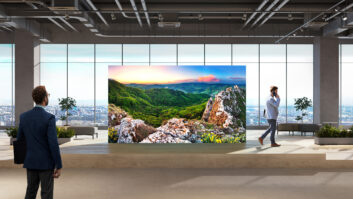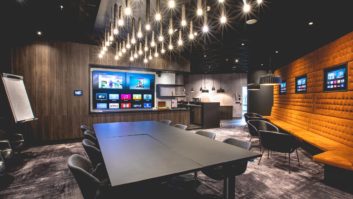At the beginning of 2020, there was optimism that digital signage (DS) was consolidating its position and seeing improvements in the sector compared to 2019. New technologies were starting to have more influence and competition was increasing as newcomers began to take business from more established companies. In his introduction to the Digital Signage Summit (DSS) during ISE last February, Florian Rotberg, managing director of invidis consulting, observed: “The market is still growing and there are a lot of opportunities.”
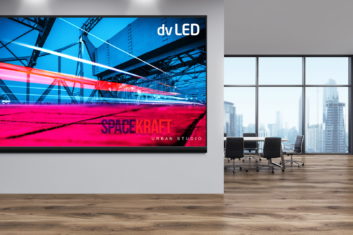 Even as the DSS was taking place, the impact of Covid-19 was already being felt in the West. For
Even as the DSS was taking place, the impact of Covid-19 was already being felt in the West. For
the DS sector this potentially meant shortages in component supplies due to the shutdown of manufacturing plants in China, although most companies had stockpiled to cover the expected closure of factories over the Chinese New Year. Rotberg warned that the situation could disrupt display production and “cascade” through 2020.
This prediction appears to be borne out by research by Futuresource, showing that quarter three of 2020 was 24 percent down on the same period in 2019.
“The DS market is undeniably under pressure and was suppressed in 2020 due to the effects of Covid-19,” explains Martin Cooke, market analyst for displays. “The market saw a slight recovery in quarter two when countries opened up after the first lockdown and projects that had been delayed or postponed because integrators could not get to site could be fulfilled. However, there are few new projects being signed off at this time, so the future remains uncertain.”
Stark forecasts
The forecast is even starker from AV and integrated systems trade body AVIXA. Its 2020 Industry Outlook and Trends Analysis expects digital signage revenues to decline by approximately 11 percent to $31bn. “The pandemic is the overall cause,” comments senior director of market intelligence, Sean Wargo. “Both hospitality and retail, the core markets for signage, have faced major declines in business. But we do expect growth to return in earnest in 2021 as revenues rise by seven percent.”
Of course, figures can sometimes paint a bleaker picture of an economic situation than is being experienced by those who work in the sector under scrutiny. “The DS market hasn’t grown as much as expected but it’s stable and advancing steadily,” says Tom Fenton, senior business development manager for Europe, the Middle East and Africa (EMEA) at display mount and kiosk specialist Peerless-AV.
“The pandemic and necessity to work remotely has had a positive impact on technology that has been trying to get into the market for some time,” he adds. “Most notably this applies to video conferencing. Covid has forced us to test and implement the technology quicker and under more strain but platforms such as Zoom, Microsoft Teams and WebEx have proved themselves invaluable for continued business collaboration, which had led to a growth in peripherals.”
Different strokes
The pandemic affected different regions in differing ways, which, according to Tobias Augustin, manager of production management at Sharp NEC Display Solutions Europe, produced a “relatively clustered situation” across EMEA. “Transportation initially remained resilient because planned refresh programmes continued and benefited from low footfall,” he comments.
“But now it is down in all regions. Live events and stadiums have been similarly affected, so we are not seeing many large installations at present. Retail and museums, however, appear to have used the quiet period to upgrade their equipment in preparation for better times. We’ve also seen a lot of mid-sized installations for signage being used to inform customers, visitors and staff about Covid safety.”
 The communications aspect of DS is picked up by David Zrihen, sales director for EMEA at Vivitek. “We have a DS solution but in the last few years leading up to 2020, the technology was not in as high demand as it is now. Now signage is everywhere, including offices, because people want to communicate information about Covid-19 restrictions and things like that.”
The communications aspect of DS is picked up by David Zrihen, sales director for EMEA at Vivitek. “We have a DS solution but in the last few years leading up to 2020, the technology was not in as high demand as it is now. Now signage is everywhere, including offices, because people want to communicate information about Covid-19 restrictions and things like that.”
Zrihen observes there has also been demand from the corporate and education markets but that installation in these areas, like so many others, had been seriously constrained by national efforts to contain the virus. “We had an installation of an LED wall in Sweden, which was affected because the install team was coming from the UK, which involved quarantine periods,” he says. “So installations have been very challenging this year but the demand is still there and people do want to invest in signage.”
Vitally important
Of the vertical markets that continue to be key to the growth of DS, retail is the sector that comes up most frequently. “It remains vitally important for signage, even with challenging business conditions,” agrees Graham Cooke of Futuresource. “Corporate signage is becoming an increasingly lucrative area, with many companies keen to show internal messaging as well as information for visitors and clients. Transportation is still a key area, although one that is being hit particularly hard in Covid times.”
Sean Wargo at AVIXA highlights hospitality alongside retail, although both have suffered during the pandemic. “Demand for signage is increasing nearly across the board, particularly transportation, education and corporate, due to the health and safety needs of the pandemic,” he says. “There is also a crossover of technologies between signage and security/life safety systems because of coronavirus.”
Peerless-AV’s Tom Fenton similarly picks out corporate and retail, saying that DS for the latter centres on providing a customer experience, with the need to improve tactics for “audience captivation and engagement”. Fenton also highlights QSR applications: “It’s another major market for DS, especially as more people choose to order takeaway food rather than eat inside restaurants currently.”
Product launches
Despite the constraints of the pandemic, the leading DS manufacturers continued to release new products and provide equipment for major installations around the world. Christie introduced the latest versions of two of its LCD ranges; the Access II discrete displays and Secure Series II, which deliver multi-source viewing without the need for a processor and are designed for military and government applications. Also launched were two new panels for the Extreme Series range of tiled LCDs, which are designed to make “near-seamless” video walls.
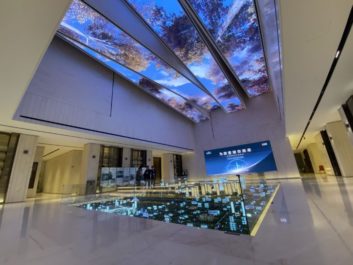 The office sector has also proved a fertile growth area for PPDS, with the C-Line and B-Line wall-mounted video whiteboards now available in EMEA. The company additionally saw opportunities through the need to display information about social distancing and counting the number of people in
The office sector has also proved a fertile growth area for PPDS, with the C-Line and B-Line wall-mounted video whiteboards now available in EMEA. The company additionally saw opportunities through the need to display information about social distancing and counting the number of people in
a particular space.
PPDS sales director Roeland Scholten comments that Covid-19 now means that going to the supermarket or visiting leisure centres required more thought and care. “Technology can play a huge role in ensuring the current rules and guidelines are maintained,” he says, “and that customers and staff feel confident, safe and well-informed at all times.”
Corporate displays
Sony expanded its BRAVIA line of professional displays in 2020 with the BZ40H, aimed at the corporate market. The company also saw increased demand for its display products to facilitate remote learning, something that became both a priority and a necessity due to the pandemic.
Covid-19 has validated the five year project to update classrooms throughout the municipal district of Bærum in Norway, with over 1200 BRAVIA screens spread across 49 schools, supported by integration with iPads, enabling students to continue their studies with as little disruption as possible.
Sharp NEC is due to launch a new range of large format displays early in 2021. The M Series offers media playback through either the integrated RPi MediaPlayer or the Intel Smart Display Module
(Intel SDM) computing device and is divided into three sub-groups. The ME (Essential) Series is
aimed at signage for retail, QSR, SME (small or medium-sized enterprise) and entry level applications; M (Mainstream) Series comprises displays for meeting rooms and the leisure/entertainment, ‘demanding’ retail and higher education sectors; while MA (Advanced) Series is designed for “mission critical environments” in manufacturing and engineering, transportation, command and control, museums and prestige retail.
LED clarification
NEC is noted for its development of LED signage and while the company’s Tobias Augustin sees that as the way forward, he feels some descriptions of the technology are misapplied.
“Terms like ‘MicroLED’ and ‘MiniLED’ are often used incorrectly,” he says. “Many second tier manufacturers claim to use these when in fact they are using standard SMDs [surface-mount devices] with a slightly smaller package size. However, MicroLED and MiniLED are quite promising and have the potential to create a new wave of installations. But cost is still quite high compared to LCD, which is why standard SMD-based LED will continue to be the major driving force in the near future. While classical LCD video walls – especially 2x2s – will become less attractive, ‘normal’ LED will be the big winner.”
At the start of 2020 Vivitek introduced the all-in-one NovoDisplay, which is able to handle 4K for Ultra HD playback and can be used for DS functions such as meeting whiteboards, welcome messages and wayfinding.
Vivitek’s David Zrihen comments that many end users investing in new, costlier technologies may make more sense than something that could be a false economy: “Some people realise that the cheap LCD walls might not be might not be the best solution for them. So they have decided to switch to LED video walls, which makes more sense. It’s still more expensive but in the long run it might be as well cheaper.”
Zrihen sees a “clear trend” for the adoption of emerging variants of LED, particularly those that are more efficient and robust than LCD. “With all the new technology for LED, where we are shifting from SMD to COB [chip on board] now, there’s a lot of improvement and I would say the technology is becoming more reliable and durable. I believe there is room for any type of product in our world.”
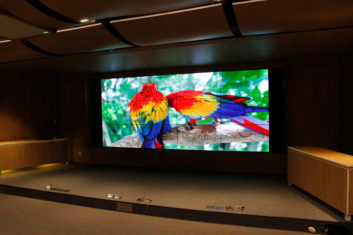 Other technological advances for signage include products incorporating IMD (inter-modulation distortion, with multiple diodes in one package) and dvLED (direct view LED) featuring increasingly smaller pixel pitches. Outdoor display, kiosk and mount specialist Peerless-AV produces the SEAMLESS Connect Series dvLED mounting system, which last year was extended to work with the Absen Acclaim Plus and Pro Series displays.
Other technological advances for signage include products incorporating IMD (inter-modulation distortion, with multiple diodes in one package) and dvLED (direct view LED) featuring increasingly smaller pixel pitches. Outdoor display, kiosk and mount specialist Peerless-AV produces the SEAMLESS Connect Series dvLED mounting system, which last year was extended to work with the Absen Acclaim Plus and Pro Series displays.
Tom Fenton at Peerless-AV observes that the indoor LED market is evolving “at a rapid pace”, with distribution of products based on the technology now better equipped to meet shorter lead times.
“From a mounting perspective, the game is changing,” he says. “The change in stocking for LED is being supported by forward thinking mount manufacturers that are enabling distributors to follow the LCD video strategy and implement it for LED. One-to-one dvLED mounting systems are now readily available, allowing for freedom for design of small to medium LED video walls.”
Signage choices
Based on market surveys and research, Martin Cooke at Futuresource disagrees with the view that LED technologies are becoming the primary basis for DS and that LCD is on the way out. “Whilst LED is definitely challenging LCD, it is not making LCD obsolete at this time,” he says. “MicroLED is in its infancy, with a very high price point and limited production. Mini LED is still a niche product. There is more adoption of standard LEDs but LCD continues to have a place in signage.”
It appears that LED is still yet to firmly establish itself in DS but even before that happens there are already other technologies and techniques emerging that could take the sector into new areas. Cooke highlights transparent and organic LED as having the potential to create “eye-catching” video walls, while interactivity will increase and evolve, particularly as a means of complying with hygiene guidelines imposed due to Covid-19. “Perhaps there will be less physical touching [of touch screens and displays] and more gesture, haptics and voice control becoming more readily integrated into systems,”
he says.
Full digital
These techniques could accelerate a transition that was identified at the 2020 DSS, the move
from DS experience (DSXP) systems to full digital experience (DXP). Stefan Schieker, a partner in invidis consulting, commented that through better interoperability, shops and service providers were able to reach more channels and gather information. But he warned that it was “a difficult step from
DSXP to DXP”, partly due to DS continuing to focus on hardware.
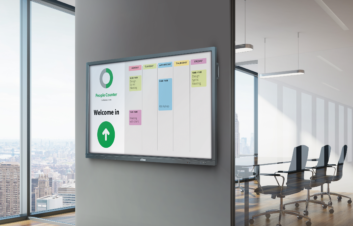 Among those attempting to move away from the norm and enable the transition from DSXP to DXP
Among those attempting to move away from the norm and enable the transition from DSXP to DXP
is Christophe Billaud, managing director of DS software developer TELELOGOS. The company has expanded into system integration as a response, Billaud said, to customer requests for management of all devices involved, not just the displays. As part of this TELELOGOS is integrating big data with DS so advertising and information can be targeted within a space, as well as gathering details about the people interacting with a display.
These technologies are already being considered by the major display manufacturers, including Vivitek. David Zrihen outlines that this involves developing applications to trigger signage based on variable factors, such as the number of people in a shop.
“Let’s say you have detected you have 50 percent of kids in your shop at a certain moment, you can
run your special promotion for that,” he explains. “And if people are signed in with mobile devices, that could indicate what sort of things they wanted or were into, triggering a specific advertisement or offer on the signage.”
Experiential advances
Greater interactivity such as this is likely to involve not just augmented reality (AR) and
other experiential technologies (see page 32 for more on mixed reality), but also a move away
from conventional displays. A contender for this is Hypervsn, which launched its 3D, holographic Solo display in 2014. Able to ‘project’ an image seemingly into the air, this device was initially viewed as a gimmick but the company has continued developing its technology, which is based on AR but does not rely on glasses or headsets, to produce other products. These include the Hypervsn Wall, which has applications in DS.
The progression of DS beyond purely displaying advertisements or information will, it seems, be enabled by AI and software in general. Among the developers looking at this is Mapwize, which began with mapping systems for way finding in smart buildings and started to expand that into DS applications for banks, hotels and other public places. This allows maps and plans to be shown on displays and kiosks or sent directly to mobile phones. Big players are also seeing opportunities with this approach: NEC is using its Anonymous Video Analytics (AVA) platform to gather information – such as the number of people in a building – and then select suitable video to be shown on the ALP display.
From its humble, almost novelty-like origins as a way to display moving posters, digital signage has become an integral part of not just advertising and promotion but also providing information in public places. Although the coronavirus pandemic has affected manufacture and installations, it has provided a new role for signage, which, through the application of emerging technologies, can only become smarter and even more a part of everyday life – whether we realise it or not.





